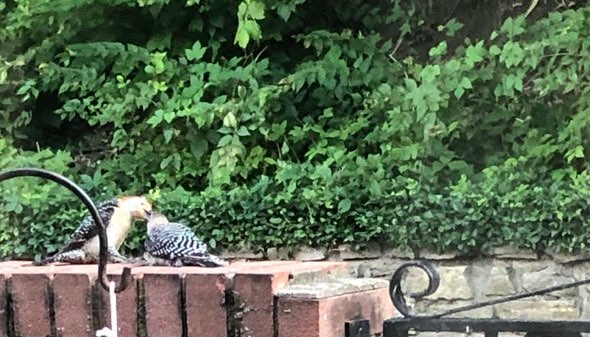Maybe during Covid I became a little too insular. Actually, I might’ve become a little too much a part of the world of nature and forgotten some social skills. But I do remember how to get dressed properly, keep myself clean and not spill. The thing is, we’re literally next door to a woods and many of my new friends who are animals don’t mind such tidiness details. We used to have dogs who died within a couple years of each other. In their old age, they needed constant attention, like eye-drops in the middle of the night so we really couldn’t travel out of town during their final months since we couldn’t find a dog-sitter who’d agree to do all the work. A few months after the dogs had passed, we decided to have outdoor pets from then on and began feeding the birds. We enjoy watching them and learning their habits, so I guess with the entertainment factor, you there’s some reciprocity.
Before I start crowing about the birds, I need to report how this winter a chipmunk and two birds invaded our house – our veritable nest! – and wrought some havoc until we managed to convince them to leave. The birds outdoors still fly at the windows when the food has run out, and the chipmunk seems interested in coming back in and chewing more of the baseboard. Because of their bullying behavior, we try to dissuade squirrels by using suet that contains hot peppers, but when I cook fish, I’ll toss the skin into the woods for the raccoons and am always happy when a possum stops by or a fox makes an appearance. Deer are less visible when the leaves are out, and always (rudely) help themselves to whatever they feel like eating from my garden.
As for the birds, we’ve gotten to know about twenty different species, some of them rare sightings like the snowy owl that stopped by for a few minutes, the pileated woodpecker that made some appearances, the western tanager that must have blown in from Colorado, and a bohemian waxwing whose presence seemed to quell all the wrangling.
It’s a little sad to learn birds’ negative traits, like how one hummingbird will claim ownership over and police a feeder and chase the others away (though they try to sneak back when the boss isn’t looking). But the boss gets his comeuppance when there’s a wasp at the feeder that wants to duke it out and the two chase each other around until they forget what they were doing and both disappear.
Nesting time is the calm before the storm – when the hatchlings emerge, the parents are practically frantic. Entomologist and author Doug Tallamy says that both chickadee parents take turns feeding their chicks, and deliver one caterpillar to the nest every three minutes. Calculating 14-hour days for two-and-a-half weeks equals somewhere in the range of 350 to 570 caterpillars every day, meaning they need six- to nine-thousand bugs to feed one clutch of chickadees. I imagine that sparrows go to the same amount of trouble so it galls me when the young birds that can fly will face their parents with beaks open and wings rapidly fluttering expecting to be fed. If we ever tried that sort of stunt, my mother would have called us “lazy louts.” One sad example of this is when a cowbird had laid an egg in a house finch nest and a gigantic infant cowbird that looks like it could swallow up mama finch whole sat there with beak open and wings trembling, insatiably begging for food.

When the parents. move on and show some tough love and the broods have only learned to eat from our patio, it gets nuts. The young sparrows even gang up on the young woodpecker who hasn’t learned that the power of his head that’s like a pneumatic drill is enough to dissuade any contender.
Oddly, the insect world seems less moody and more logical, more down to earth, as it were. As an organic gardener and indigenous plant collector forever, I’ve formed a relationship with pollinators and even have registered my garden with a county ecological organization as a pollinator garden. Once when my husband visited me in the garden, he noticed a bumblebee hovering above my shoulder as if watching my every move. And yesterday I rescued a butterfly from the local pool – I thought it was surely dead, but after a few minutes it stood up, dried off and flew away. But if insects come inside and think I won’t mind them flying around, they’ve got another think coming.

Have you read SYLVIE DENIED yet? I invite you to grab your copy, and please leave an honest review when you do.

Perfect! I add my own negative reinforcement to insects in the house, but they don’t seem to learn vey quickly.
Susan — I learned in a psychology class that intermittent positive reinforcement is most effective. But I admit I can’t think of a way to show indoor insects the benefits of _not_ being in your house. If they’re inside and die of starvation, they can’t pass along that knowledge to others. Which brings to mind the deer that die when they cross at the “no deer crossing” signs. At the last minute they might have thought “oh, now I understand!” but that knowledge dies with them.